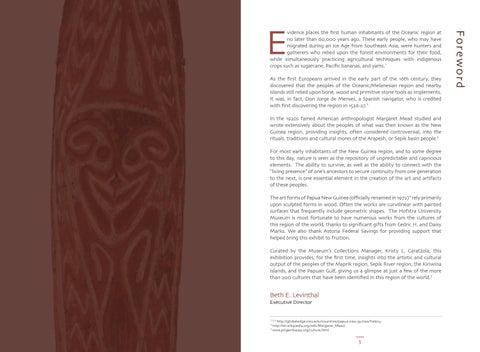As the first Europeans arrived in the early part of the 16th century, they discovered that the peoples of the Oceanic/Melanesian region and nearby islands still relied upon bone, wood and primitive stone tools as implements. It was, in fact, Don Jorge de Menses, a Spanish navigator, who is credited with first discovering the region in 1526-27.2 In the 1920s famed American anthropologist Margaret Mead studied and wrote extensively about the peoples of what was then known as the New Guinea region, providing insights, often considered controversial, into the rituals, traditions and cultural mores of the Arapesh, or Sepik basin people.3 For most early inhabitants of the New Guinea region, and to some degree to this day, nature is seen as the repository of unpredictable and capricious elements. The ability to survive, as well as the ability to connect with the “living presence” of one’s ancestors to secure continuity from one generation to the next, is one essential element in the creation of the art and artifacts of these peoples. The art forms of Papua New Guinea (officially renamed in 1972)4 rely primarily upon sculpted forms in wood. Often the works are curvilinear with painted surfaces that frequently include geometric shapes. The Hofstra University Museum is most fortunate to have numerous works from the cultures of this region of the world, thanks to significant gifts from Cedric H. and Daisy Marks. We also thank Astoria Federal Savings for providing support that helped bring this exhibit to fruition. Curated by the Museum’s Collections Manager, Kristy L. Caratzola, this exhibition provides, for the first time, insights into the artistic and cultural output of the peoples of the Maprik region, Sepik River region, the Kiriwina Islands, and the Papuan Gulf, giving us a glimpse at just a few of the more than 200 cultures that have been identified in this region of the world.5
Beth E. Levinthal Executive Director
http://globaledge.msu.edu/countries/papua-new-guinea/history http://en.wikipedia.org/wiki/Margaret_Mead 5 www.pngembassy.org/culture.html 1, 2, 4 3
5
F o r e wo rd
E
vidence places the first human inhabitants of the Oceanic region at no later than 60,000 years ago. These early people, who may have migrated during an Ice Age from Southeast Asia, were hunters and gatherers who relied upon the forest environments for their food, while simultaneously practicing agricultural techniques with indigenous crops such as sugarcane, Pacific bananas, and yams.1

